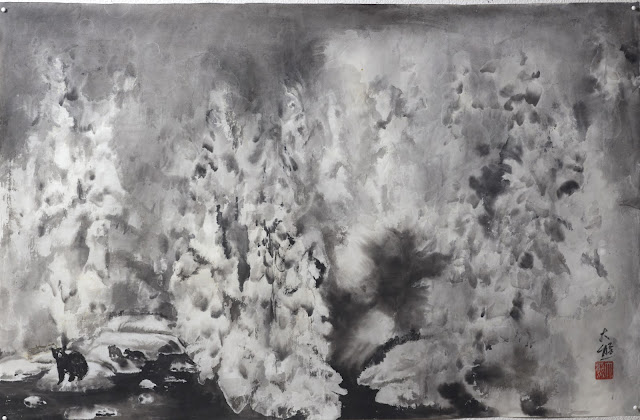Those of you who followed my blog know that I've on many occasions used alum solution for my painting. I've affectionately called alum solution as my Ancient Chinese Secret Solution. I believe my first attempt was marked by my "Splash" painting. I've also tried to experiment with egg whites and epsom salts but was disappointed by the results.
The role of alum for me has been relegated to a supporting cast status. I intend to give it a major role in the sense that my painting would be dictated by the artful utilization of alum. I plan to use alum as my "color". Alum solution is used to size
Xuan, the paper we paint on. My friends who does
Gongbi style brush painting use alum as a mordant when they paint on sized
Xuan or silk.
I like alum solution because it works as a masking solution for me. I know watercolorists use a solution that dries to form a rubber mask to conceal void spaces. I am referring to the Resist solution. One can paint over such areas and then peel off the rubber mask to reveal the protected area. The fragility of the
Xuan absolutely prohibits such practice. The rubber mask would destroy and tear the paper when attempting to lift it off the surface. The fact that alum imparts some impermeability to subsequent coloring could be attributed to the fact that it acts as a fixer. It fixes the ink or pigment that is mixed with it. Because the ink or color is fixed before the brushstroke dries, and as the rest of the solution in the brushstroke continues to slowly migrate through the fibers in the paper, a clear margin forms around the imprint of the brushstroke. This clear margin is exploited to give the effect of back-lit subjects.
I started by exploring the nuances of painting with alum solution. I scribbled various lines on my
Xuan, employing alum solution along with various tonal colors of ink.
Notice the clear demarcation around the individual brushstrokes.
Then I tried something with a little more drama. I used a very wet brush loaded with alum solution with ink on the tip of my brush.
All those brushstrokes were meant to be contiguous, and yet there were clear margins around each brushstroke.
The above is the backside of my doodling. The photo itself does not tell the whole story. I believe the smartphone has built in level adjustment, thus making the image more vivid than it truly is. Nonetheless, I think the effect of the demarcation is even more pronounced than the front.
What I wanted to paint was a snow scene. I would attempt to paint my snow with alum solution. Instead of reserving a blank space for snow, I used alum solution, combined with various shades of ink, to paint the appearance of snow.
First I started with the element of interest in my painting. Following the rule of thirds, I folded a line that is one-third the height of my painting and that's where I spotted my elk.
A close-up of my animal. The presence of alum solution in my brush rendered each brushstroke distinctly.
My next task was to see how I could effectively portray snow covered trees. I decided to model the trees after the firs and lodge pole pines that are so prevalent here. I began my trial and error by using simple dots. Dots of different shades of alum solution. Note that I painted on the back of my paper. The fact that the images on the back side looked better than top side gave me that direction.
I tried using two brushes. One with alum solution and the other with ink, I wanted to see if I could effect a more realistic representation of snow covered trees. I painted the darker poles on the top side of the paper, hoping the interplay of front and back side would add to the ambiguity and therefore the nondescript feel of snow covered trees.
So far I was dotting my "snow" and painting in the tall poles of fir. The vertical lines of these fir trees should give my painting a structure.
The above was the back of the snow brushstrokes but the top side for painting the tree poles. Confused? That was my premise. Exploiting the translucent
Xuan by employing both surfaces as my canvas.
For the other half of the painting, I changed my method of painting. I painted individual trees and tried to assemble the additional members in a cohesive manner.
Close-up if my snow effect. Notice the translucent dabs formed by footprint of my alum solution.
The same image on the reverse side of the paper. Again, it seemed to present the feel of snow better.
So this is what I ended up with
I can't remember which side is the front or back now.
So is this a painting about a snow covered woods or about an elk? I'm re-living my moments of painting my Korean Maidens.































